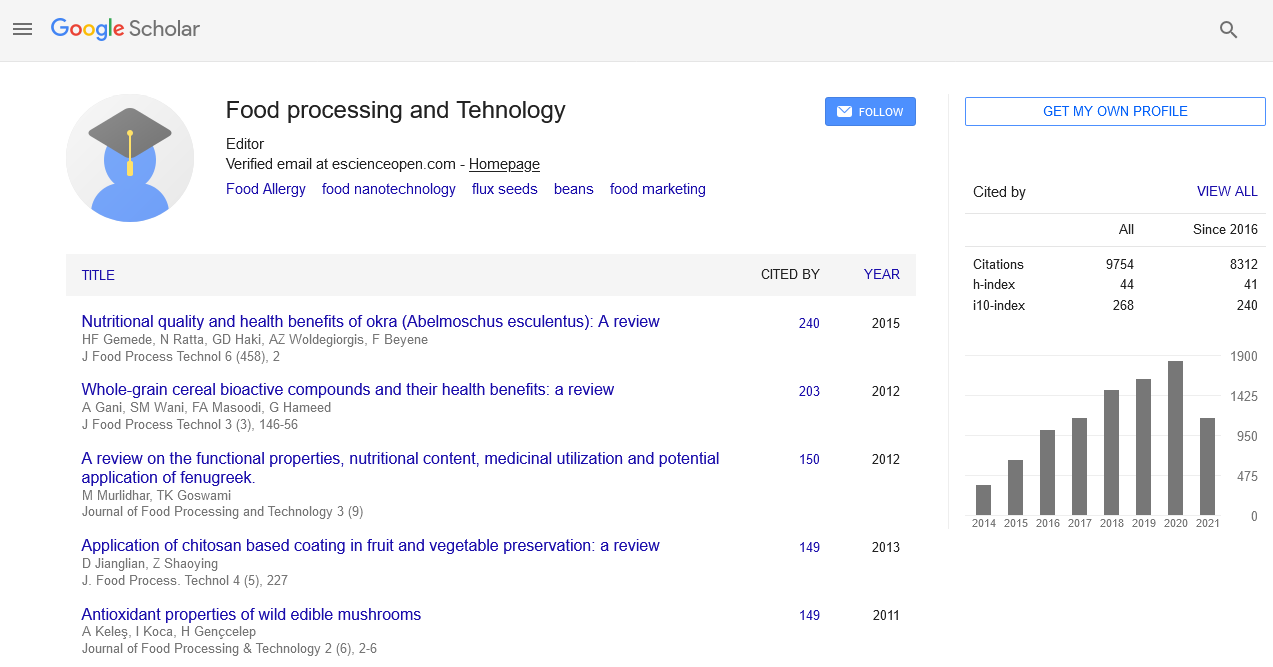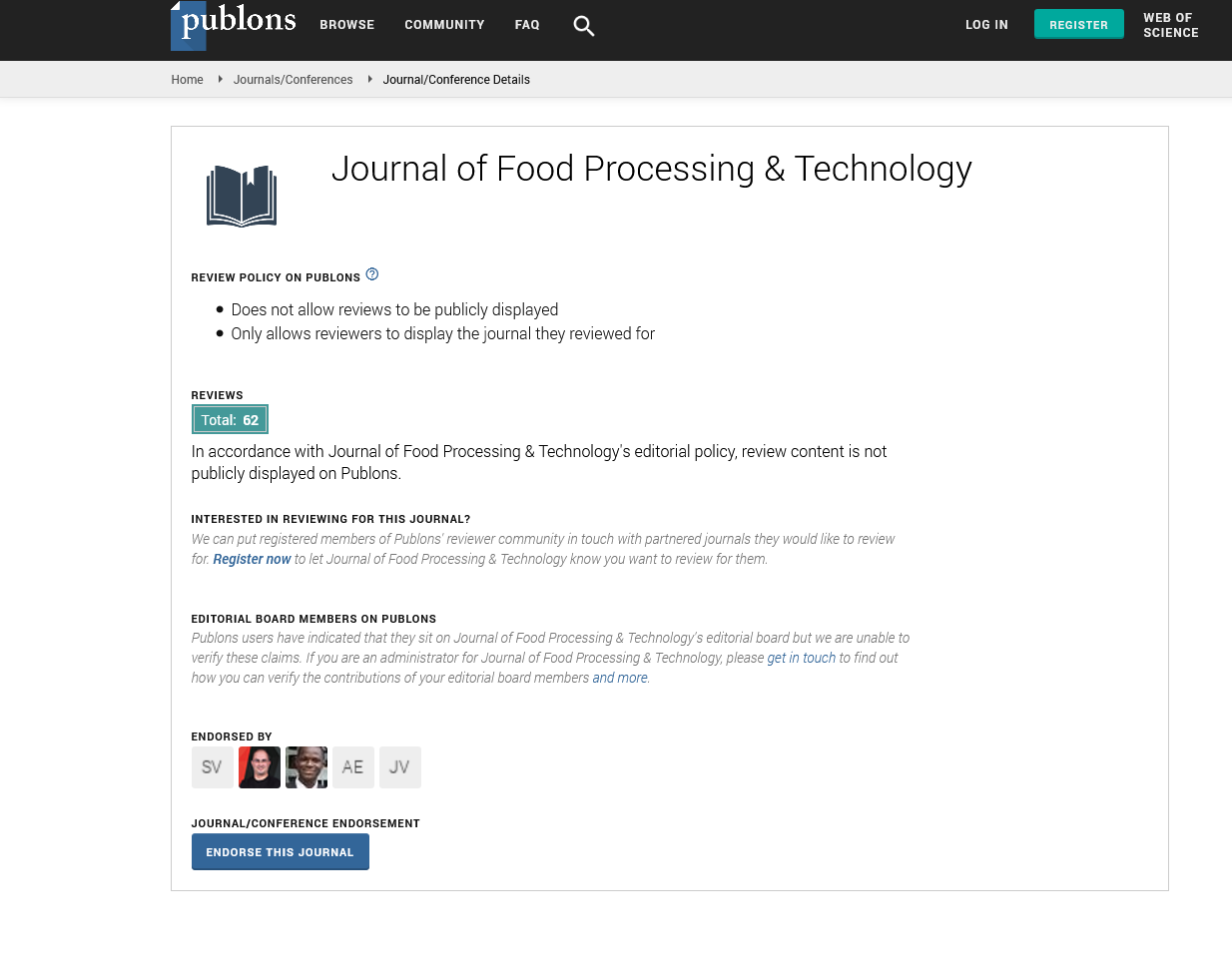Indexed In
- Genamics JournalSeek
- Academic Keys
- JournalTOCs
- China National Knowledge Infrastructure (CNKI)
- Access to Global Online Research in Agriculture (AGORA)
- Centre for Agriculture and Biosciences International (CABI)
- RefSeek
- Directory of Research Journal Indexing (DRJI)
- Hamdard University
- EBSCO A-Z
- OCLC- WorldCat
- Scholarsteer
- SWB online catalog
- Publons
- Euro Pub
- Google Scholar
Useful Links
Share This Page
Journal Flyer
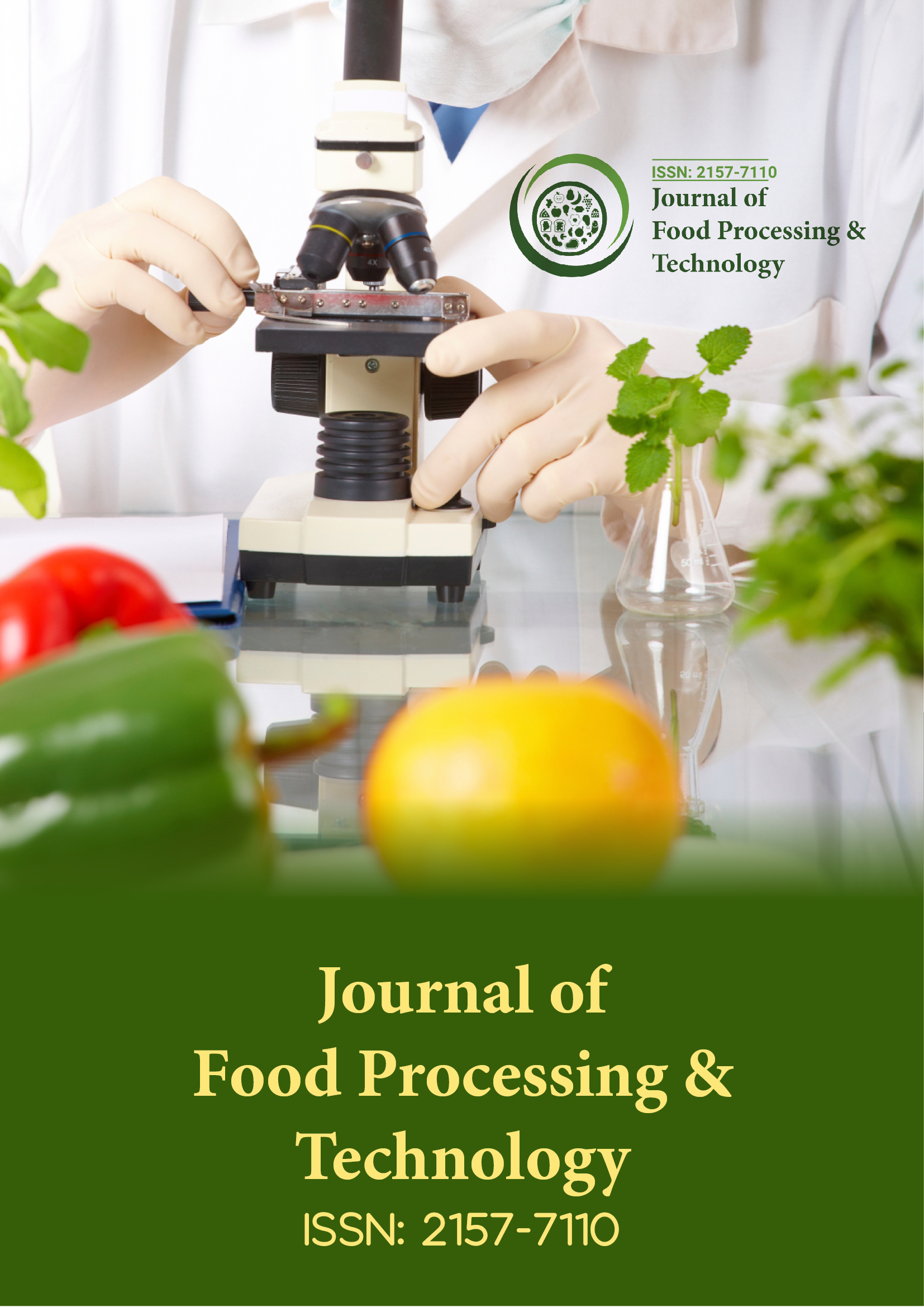
Open Access Journals
- Agri and Aquaculture
- Biochemistry
- Bioinformatics & Systems Biology
- Business & Management
- Chemistry
- Clinical Sciences
- Engineering
- Food & Nutrition
- General Science
- Genetics & Molecular Biology
- Immunology & Microbiology
- Medical Sciences
- Neuroscience & Psychology
- Nursing & Health Care
- Pharmaceutical Sciences
Research Article - (2023) Volume 14, Issue 12
A Glimpse on Indian Honey Exports in Global Market
Shanmuganathan S* and Gopalsamy SReceived: 09-May-2023, Manuscript No. JFPT-23-21291; Editor assigned: 12-May-2023, Pre QC No. JFPT-23-21291 (PQ); Reviewed: 26-May-2023, QC No. JFPT-23-21291; Revised: 10-Jul-2023, Manuscript No. JFPT-23-21291 (R); Published: 17-Jul-2023, DOI: 10.35248/2157-7110.23.14.1082
Abstract
The honey bee is one of humanity's most significant insects. Humans and honey bees are among the few creatures that benefit each other. The global organic honey market had 606.2 million U.S. dollars in 2019, and was forecasted to reach 923.6 million U.S. dollars by 2025. Honey production volume as of 2018 data, china stands tall with 31.4% production followed by turkey 6.9%, Russia 5%, Iran 5% other countries constitute roughly 41% production combinable. This research paper discusses the work flow involved in the export of Indian honey from peasants to manufacturers, as well as the regulatory requirements for exporting Indian honey to the worldwide market. The growth of the Indian honey industry has been significantly reduced in the last two years because of a wide range of factors. Measures implemented by the national bee board to reinvigorate the industry have been discussed.
Keywords
Honey; Heart disease; Antibacterial; Antiseptic; Crystallisation
Introduction
Honey has a significant amount of antioxidants and flavonoids, which can help to reduce oxidative stress and inflammation in the body while also protecting against heart disease and cancer [1]. Aside from that, honey has antibacterial and antiseptic properties that help wound and burn healing by keeping the wound moist and improving the flow of nutrients to the affected area. Because of these causes, the need for honey has increased market appeal for home cures. Honey has become a significant product in today's organic world [2]. Scientific validation of honey's therapeutic use and its increasing value as a premium ingredient in nutritional supplements are also important market drivers in both the national and global markets. When it comes to exporting honey from India to the worldwide market, the only main concerns are antibiotics and adulterants [3].
Indian honey flora and fauna
In terms of flavour, multiflora honey is the most popular honey flavour in India. Export based honey flavours include Eucalyptus honey, Ajwain honey, mustard honey, lychee honey, sunflower honey, karanj/pongamea honey, multi-flora Himalayan honey, acacia honey, wild flora honey, multi and mono floral honey. Kashmiri honey and Acacia honey are the high demand varieties in export [4-9]. Due to climatic conditions, most export oriented businesses operate in Northern India rather than Southern India. Rajasthan, Punjab, Uttar Pradesh, Himachal Pradesh, Bombay, West Bengal, and Kashmir provide the highest percentage of production to export companies.
Indian honey exports
Beekeepers in India are registered with the national bee board, yet there are still a large number of beekeepers in India who haven't registered. In comparison to the Indian diary cooperative society, it is an unorganized sector. Hence, traders used to buy honey from scattered farmers and mobilized bee keepers based on cultivation season. Mustard honey relatively contributes higher batches to the global export. Mustard honey is often produced in and around northern hemisphere of India with a high FG ratio, which itself is accountable for honey crystallisation [10]. If the FG ratio is higher, it will crystallize considerably quicker. The storage temperature has a significant impact in honey crystallisation. Honey crystallisation occurs most quickly at 10℃ to 15℃ (50°F to 59°F). Crystallisation is slowed at temperatures below 10℃ (52°F). Low temperatures increase the viscosity of honey, which slows crystal formation and diffusion. Honey resists crystallisation best at temperatures above 25℃ (77°F). The crystals disintegrate around 40℃ (104°F), temperatures above 40℃ (104°F) will harm honey's qualities [11].
Farmers used to sell their hand holdings to traders in their region for between 50 and 150 rupees per kilogramme. Rate fluctuates continuously dependent on demand and supply. When we were on a field trip with the national science foundation auditor in the interiors of Uttar Pradesh, the majority of farmers are statistically significant if they receive between 90 and 105 rupees per kilogramme [12]. They are unable to maintain shore properties to execute beekeeping activities in their separate fields if their income falls below 70 rupees. Most farms had 100-200 boxes on average, but no more than that. Some of them had as much as 500 boxes. Because a particular farmer's and beekeeper's production capability is not at its peak, they are unable to approach firms directly for trading another drawback is the distance between the companies and the manufacturer's location. These factors rise to a new type of intermediary in this industry called as a trading agency [13]. Due to commercial considerations, the trading agency used to buy honey from several small merchants using their connections and information, which they solely kept. The export inspection council's executive order for honey includes a quarterly field visit to check the hygiene and quality standards established by them. The risk of price fluctuation and adulterant scope begins here, depending on demand and supply from manufacturers. Manufacturing units only make purchases through agencies based on the annual contracts signed between trade agencies and them for the fiscal year. Little bee impel and sun land trading agency are the most common importers from the United States.
Materials and Methods
Sampling of raw honey
As the consignment arrives at the manufacturing unit, sampling is done bucket by bucket using SS rods, with each 50 buckets having a single sample part. If the consignment contains 400 buckets, it is divided into eight equal halves. The 8 components would then be effectively mixed together to form a single part [14]. Prior to testing, sampling is critical. If effective sampling is not performed, there is a risk of test findings mismatching, resulting in a defective end product. The sampling is managed by the quality assurance department using a check list provided by the EIA. In house raw honey testing is permitted by the regulatory body norms as well as clients from global markets. Since the majority of countries consider finished product findings from Intertek Germany as a reliable resource and pioneer in this industry. Raw material testing is performed for seven different antibiotic groups, and wet lab testing is performed in accordance with EIA guidelines. Only pass batches progress to the next level, production unit. After testing, all raw honey batches are stored in a cold storage chamber. Temperatures are typically maintained between 16℃ and 26℃.
Export price
Colour has a significant impact on honey prices in the export market. When the colour is substantially lower, the price rises as the colour rises, the price falls. A measurement tool is used to determine the colour of the honey. The Gulf countries have a large market for Indian darker and amber colored honey, but juice manufacturers of same region prefer low intensity colour, mostly extra light amber and light amber based contracts are highly manufactured by Indian companies for export (Table 1).
| Colour | Description |
|---|---|
| 0 mm-8 mm | Water white |
| 9 mm-17 mm | Extra white |
| 18 mm-34 mm | White |
| 35 mm-50 mm | Extra light amber |
| 51 mm-85 mm | Light amber |
| 86 mm-114 mm | Amber |
| 115 mm-200 mm | Dark |
Note: Measured in Pfund
Table 1: Colour and description of honey.
Honey processing
The production manager issues batches based on the raw material test results, bearing export agreement elements in account most contracts contain the parameters listed below. Moisture content of 18%, antibacterial and nicotinoids-free honey, quantity and colour requirements. Honey is treated reasonably simple at the manufacturing site it is fed first into a heating chamber where waxes are removed and passed through a sub-micron filter. The product is then transferred from several heating chambers to a homogenization tank, where it is blended for 5 to 6 hours and held for 3 hours before being filled in food grade drums, each weighing 300 kg. A total export shipment amounts of 18.2 metric to 18.6 metric tons of honey. This sector's HACCP critical control points are moisture content and effective filtration. Drums are labelled with the country of origin, batch number, date of filling, and drum number. These drums are kept in the finished goods section. On a monthly basis, the national bulk handling crop oversees pest management in the plant premises. After each batch processed the plant is washed by hot water. As well as surface swab and hand swab testing is done on regular intervals in order to ensure there are zero microorganism growth and zero contamination [15]. A member of the national science foundation comes to pursue random sampling with his presence, those samples are scheduled for finished sample testing at Intertek Deutschland. Manufacturers will be waiting for the results if they meet the contract specifications, they will be loaded into containers under the supervision of an NSF inspector. They seal the container to ensure there is no maltreatment during shipping. In the case of the honey industry in Uttar Pradesh, their shipment arrives in Delhi via container Cargo and is then moved to Mumbai via rail, from where it is transported to destination countries via cargo ship.
After being shipped from the production site, it may take up to 65 days to arrive in the United States. Several other manufacturing facilities are following the same approach.
Adulteration
Lately, the business suffered a significant setback due to an unanticipated drop in exports compared to the fiscal years 2007-2017. It could be owing to adulterant and surrounding nations of the United States having a self-sufficient stock for immediate deployment due to demand and supply ratio. Several shipments of honey were halted by food safety authorities from the European Union and the United States due to the presence of lead and prohibited animal antibiotics.
Furthermore, they discovered that an even greater amount of honey had been concocted without the assistance of bees, with the majority of them being made from artificial sweeteners and then extensively filtered to remove any proof of contaminants, adulteration, or indications on the same in in order to mislead the testing department precisely on the honey's actual origin. China was initially supplying enough quantities of honey to the United States, but regulatory authority examinations and findings revealed that the majority of them were adulterated with corn syrup. Corn syrup behaves like inverted sugars and, once heated, cannot be distinguished from honey because it turns yellow. Honey exports from India increased dramatically after the United States slapped an embargo on China. The Indian export sector performed successfully for several years, most notably from 2007 to 2017. However, the lack of an organised framework and adulterants resulted in a significant setback for the sector (Table 2).
| Year | Production in MT | Cumulative Production in MT |
Percent | Cumulative percent |
|---|---|---|---|---|
| 2010-2011 | 25979.21 | 25979.21 | 4.4 | 4.4 |
| 2011-2012 | 26089.03 | 52068.24 | 4.42 | 8.82 |
| 2012-2013 | 25780.7 | 77848.94 | 4.37 | 13.18 |
| 2013-2014 | 28378.4 | 106227.3 | 4.81 | 17.99 |
| 2014-2015 | 29578.56 | 135805.9 | 5.01 | 23 |
| 2015-2016 | 38177.04 | 173982.9 | 6.46 | 29.46 |
| 2016-2017 | 45055.45 | 219038.4 | 7.63 | 37.09 |
| 2017-2018 | 51547.31 | 270585.7 | 8.73 | 45.82 |
| 2018-2019 | 61333.9 | 331919.6 | 10.39 | 56.21 |
| 2019-2020 | 59536.76 | 391456.4 | 10.08 | 66.29 |
| 2020-2021 | 59999.25 | 451455.6 | 10.16 | 76.45 |
| 2021-2022 | 74413.06 | 525868.7 | 12.6 | 89.05 |
| 2022-2023* | 64682.97 | 590551.6 | 10.95 | 100 |
Note: *Data 2022-2023 resembles April to December.
Table 2: Pareto numeric report production-in-MT.
Testing equipment’s
Honey manufacturing sites are equipped with high end equipment’s like LCMS/MS (Liquid Chromatography Mass Spectrometer) for antibiotics testing and IRMS (Isotope Ratio Mass spectrometer) for C4 sugar tests and heavy metals testing specifically for lead by ICPMS inductively coupled plasma mass spectrometry to cross verify the adulteration in raw honey procurement (Table 3).
| Year | Value in crores | Cumulative value in crores | Percent | Cumulative percent |
|---|---|---|---|---|
| 2010-2011 | 300.87 | 300.87 | 3.53 | 3.53 |
| 2011-2012 | 321.24 | 622.11 | 3.76 | 7.29 |
| 2012-2013 | 356.32 | 978.43 | 4.17 | 11.46 |
| 2013-2014 | 445.01 | 1423.44 | 5.21 | 16.68 |
| 2014-2015 | 535.1 | 1958.54 | 6.27 | 22.95 |
| 2015-2016 | 705.87 | 2664.41 | 8.27 | 31.22 |
| 2016-2017 | 557.79 | 3222.2 | 6.54 | 37.75 |
| 2017-2018 | 653.58 | 3875.78 | 7.66 | 45.41 |
| 2018-2019 | 732.19 | 4607.97 | 8.58 | 53.99 |
| 2019-2020 | 633.79 | 5241.76 | 7.43 | 61.41 |
| 2020-2021 | 716.13 | 5957.89 | 8.39 | 69.81 |
| 2021-2022 | 1221.18 | 7179.07 | 14.31 | 84.11 |
| 2022-2023* | 1355.96 | 8535.03 | 15.89 | 100 |
Note: *Data 2022-2023 resembles April to December.
Table 3: Pareto numeric report value in crores.
Results and Discussion
Action plans
NBB has 9698 registered bee keepers across India, with a total of 1559771 colonies. Assistance is offered under MIDH, which is conducted by the state departments of horticulture, for the promotion and development of scientific beekeeping in the country. NBB is also one of the MIDH's National Level Agencies (NLAs) (Figure 1). The national bee board is attempting to involve the NDDB, GCMMF, milk federation, and co-operative society in order to structure and lead the sector in a healthy manner. NBB is establishing integrated bee development centres in 16 Indian states (Table 4). The national bee board is also financing the establishment of a sophisticated laboratory for honey testing at the NDDB in Gujarat. Substantially all these are heading to increase the number of skilled and NBB registered bee keepers in the nation. The national bee board technical committee provided operational guidelines for the October 2019 national bee keeping and honey mission. During the fourth session of the Coronavirus pandemic relief package, finance minister Mrs. Nirmala Sitharaman emphasised the importance of beekeeping and provided an Rs 500/- crore relief packages exclusively for the beekeeping industry (Figure 2). During her address, she also mentioned that the wax used in the domestic market is imported, and that if we boost beekeeping, we would be selfsufficient and will not need to import wax. The funds will be utilised for infrastructure development connected to an integrated beekeeping development centre, collection, marketing, and storage centres, post-harvest, and value addition facilities, which would boost the per person income of 2 lakh beekeepers in India.
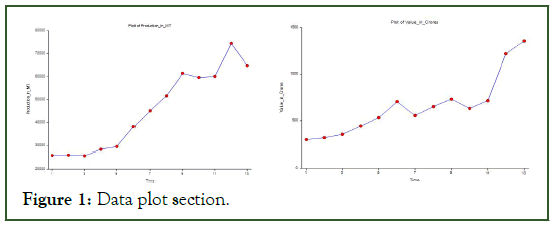
Figure 1: Data plot section.
| Lag | Co-relation value | Lag | Co-relation value |
|---|---|---|---|
| -10 | -0.387377 | 0 | 0.84135 |
| -9 | -0.355993 | 1 | 0.532367 |
| -8 | -0.343778 | 2 | 0.289877 |
| -7 | -0.239964 | 3 | 0.209939 |
| -6 | -0.066294 | 4 | 0.083733 |
| -5 | 0.055785 | 5 | -0.096219 |
| -4 | 0.253915 | 6 | -0.178866 |
| -3 | 0.388571 | 7 | -0.261049 |
| -2 | 0.480117 | 8 | -0.348584 |
| -1 | 0.719143 | 9 | -0.34028 |
| 10 | -0.310319 |
Table 4: Lag and co-relation value.
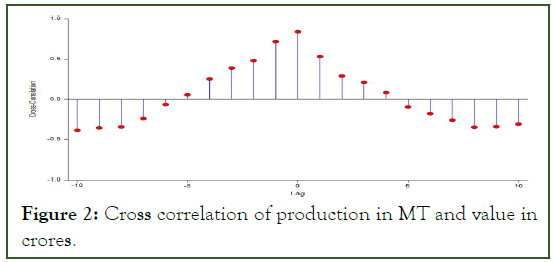
Figure 2: Cross correlation of production in MT and value in crores.
The above area under the curve was illustrated by the variables as production in metric ton and export values in crores. The maximum export value was 1355.96 during the year 2022 to 2023 (Figure 3). The maximum production value was 74413 during the year 2021 to 2022. It is concluded to be there is a substantial gap between the Indian honey export value and volume exports comparing to other global nations such as New Zealand, Argentina, Germany, Ukraine, Spain, Brazil and Hungary (Figure 4).
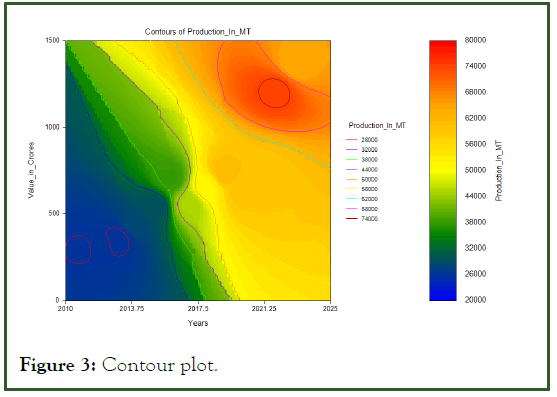
Figure 3: Contour plot.
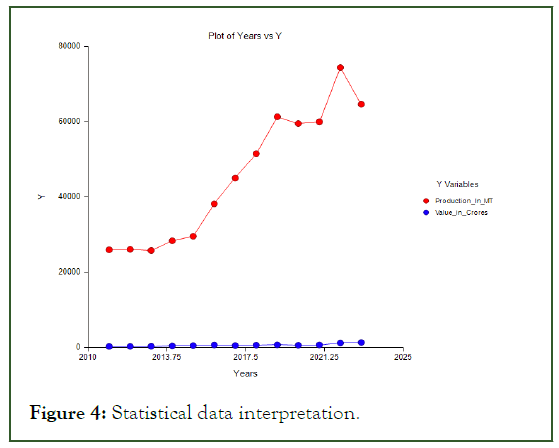
Figure 4: Statistical data interpretation.
Conclusion
MPEDA can be used as an exemplary regulatory organisation because it has experienced significant increase in exports year after year. Export inspection officials can conduct surprise audits on manufacturing plants on a regular basis to strictly prohibit adulteration in industrial facilities. NBB can double check and keep an eye out for plant-based vegan products manufactured in China. In addition to routine authenticity testing, natural occurring chemicals such as pinocembrin, apigenin, cardamomin, luteolin, quercetin, chrysin, and tectorigenin abundance in honey can be determined to establish the origin of the country. NBB should meticulously tally export data with bee keeper colonies production data. As a consequence, recent honey exports for the years 2021 to 2023 have exceeded the 1000 crore benchmark in terms of global exports.
References
- Pandey A, Pradheep K, Gupta R, Nayar ER, Bhandari DC. Drumstick tree (Moringa oleifera Lam.): A multipurpose potential species in India. Genet Resour Crop Evol. 2011;58:453-460.
- Sackley N. The road from serfdom: Economic storytelling and narratives of India in the rise of neoliberalism. Hist Technol. 2015;31(4):397-419.
- Shukla S, Shankar R, Singh SP. Food safety regulatory model in India. Food Control. 2014;37:401-413.
- Dabic M, Obradovic T, Vlacic B, Sahasranamam S, Paul J. Frugal innovations: A multidisciplinary review and agenda for future research. J Bus Res. 2022;142:914-929.
- Mahapatra A, Mitchell CP. Sustainable development of non-timber forest products: Implication for forest management in India. For Ecol Manag. 1997;94(1-3):15-29.
- Martinez-Torres ME, Rosset PM. La via Campesina: The birth and evolution of a transnational social movement. J Peasant Stud. 2010;37(1):149-175.
- Chatterjee S, Dhole A, Krishnan AA, Banerjee K. Mycotoxin monitoring, regulation and analysis in India: A success story. Foods. 2023;12(4):705.
[Crossref] [Google Scholar] [PubMed]
- Wreford A, Bayne K, Edwards P, Renwick A. Enabling a transformation to a bioeconomy in New Zealand. Environ Innov Soc Transit. 2019;31:184-199.
- Sanches-Pereira A, Onguglo B, Pacini H, Gomez MF, Coelho ST, Muwanga MK. Fostering local sustainable development in Tanzania by enhancing linkages between tourism and small scale agriculture. J Clean Prod. 2017;162:1567-1581.
- Houston L, Capalbo S, Seavert C, Dalton M, Bryla D, Sagili R. Specialty fruit production in the Pacific Northwest: Adaptation strategies for a changing climate. Clim Change. 2018;146:159-171.
- Khanam Z, Singh O, Singh R, Bhat IU. Safed musli (Chlorophytum borivilianum): A review of its botany, ethnopharmacology and phytochemistry. J Ethnopharmacol. 2013;150(2):421-441.
[Crossref] [Google Scholar] [PubMed]
- Havens T. It's still a white world out there: The interplay of culture and economics in international television trade. Crit Stud Media Commun. 2002;19(4):377-397.
- Gordon D. From rituals of rapture to dependence: The political economy of khoikhoi narcotic consumption, c. 1487-1870. S Afr Hist J. 1996;35(1):62-88.
- Miraj SS, Parveen N, Zedan HS. Plastic microbeads: Small yet mighty concerning. Int J Environ Health Res. 2021;31(7):788-804.
[Crossref] [Google Scholar] [PubMed]
- Alexandratos N. Countries with rapid population growth and resource constraints: Issues of food, agriculture, and development. Popul Dev Rev. 2005;31(2):237-258.
Citation: Shanmuganathan S, Gopalsamy S (2023) A Glimpse on Indian Honey Exports in Global Market. J Food Process Technol. 14:1063.
Copyright: �© 2023 Shanmuganathan S, et al. This is an open access article distributed under the terms of the Creative Commons Attribution License, which permits unrestricted use, distribution, and reproduction in any medium, provided the original author and source are credited.
